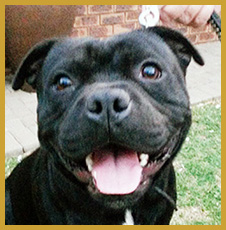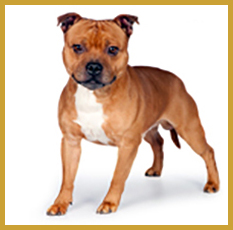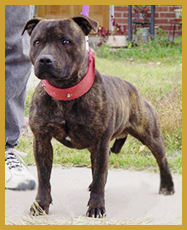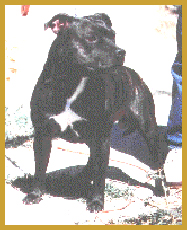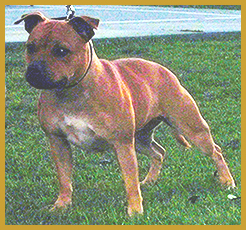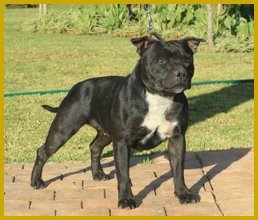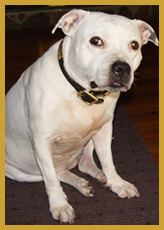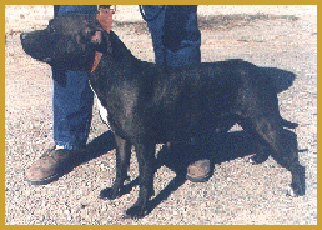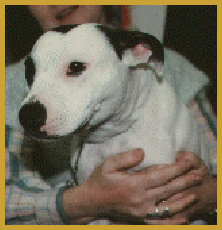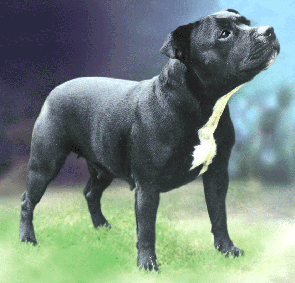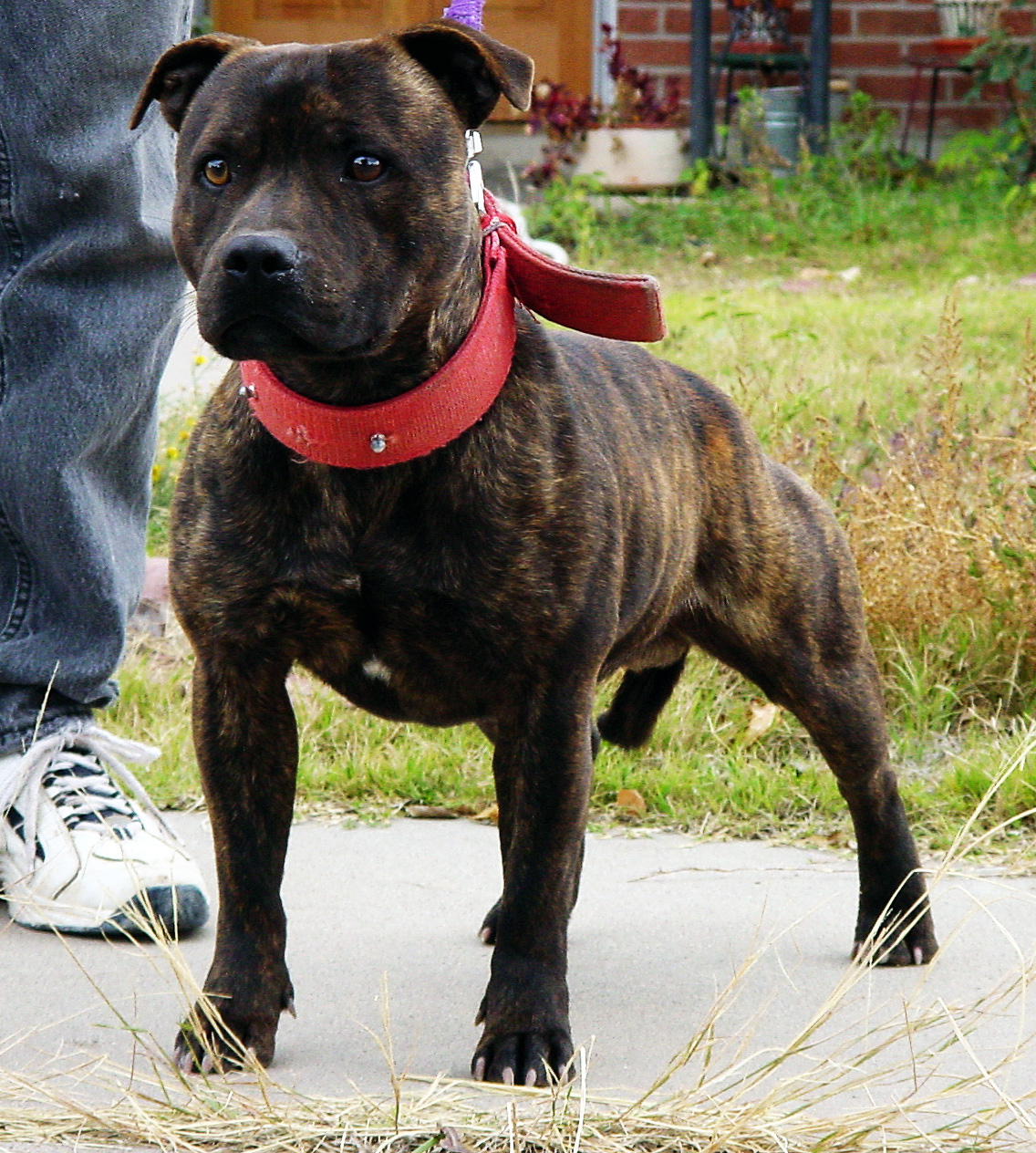History and discussion of the Staffordshire Bull Terrier Breed Standard
Firstly, to clarify the point about who uses which Standard:
South Africa and Australia both use the English Standard - both of our Kennel Clubs have the policy of using the Standard of the Country of Origin. Whatever Standard is used in the country where the breed was developed is what we use.
The English Kennel Club adopts the same policy - they use our Standard for the Rhodesian Ridgeback because South Africa is the Country of Origin. There is one exception, that I know of, to this rule - the Glen of Imaal Terrier. England has strayed away from this Standard and adopted their own - with HUGE controversy. South Africa, for one, still uses the Irish version of the Glen of Imaal Standard - since Ireland is the Country of Origin.
In New Zealand the "old" (i.e. "1948") English Standard is used, with some changes. When the English Kennel Club "standardized" their Standards the NZ Kennel Club was prepared to adopt them or not, depending upon the decision of the individual breed clubs. The Stafford Clubs decided to stay with the "old" and, in their opinion, better Standard. However they have included the movement clause from the "new" Standard.
In NZ it's split about half and half between breeds which have adopted the "new" version of the old English Standards and those which opted to stay with the original Standard (i.e., those in force in the UK prior to standardization). Other breeds have since adopted different Standards again, but in general the New Zealanders tend to follow the UK Standards in preference to the US (or FCI) Standards.
Country of Origin was the original basis for the selection of a Standard in NZ but this appears to have fallen by the wayside depending upon which "clique" has the biggest voice in the breed clubs.
The USA has changed the Staffordshire Bull Terrier Standard slightly of their own accord. Presumably this is because the USA doesn't adopt a Country of Origin policy - unlike most Kennel Clubs around the world.
Whether these various different Standards in existence is a good thing, or a bad thing - well, who's to say!
I'm afraid to be the bearer to bad news, but unfortunately the ENGLISH Standard that is printed in the Pounds & Rant book is NOT correct. I do have a copy of this book and I personally have never seen this version of the Standard anywhere else before and do not know where it comes from! Perhaps printer's gremlins are to blame? Who knows! Just goes to prove how vital it is to check that the right information is being printed - and how important accuracy is!
Copies of the latest (1987) and currect English Standard can be found in the following publications, to name but a few:
- The Kennel Club's Illustrated Breed Standards
- John F Gordon's The Staffordshire Bull Terrier (1989 edition)
- Dieter Fleig's Staffordshire Bull Terrier
- Danny Gilmour's The Complete Staffordshire Bull Terrier
- Anna Katherine Nicholas' The Staffordshire Terriers (although she calls it "the 1949 version"!)
- North West Staffordshire Bull Terrier Club 1946 - 1996 Golden Jubilee Booke
- The Ring Volumes 12, 13, 14, 15, 16 & 17
The North West SBTC Jubilee book is very useful when attempting to understand our Breed's history. There are pages of reprinted correspondence between clubs and individuals from the time when the Standard was changed both in 1948 and in 1987. Such correspondence is vital reading when trying to interpret the Standard - especially since many of the letters contain graphic descriptions which are far more explanatory that the Breed Standard itself!!
Now, what about the history of the Breed Standards (as far as England and those countries that use the English Standard are concerned):
The First Standard was drawn up with the recognition of the Breed by the English Kennel Club in 1935, the Second Standard took effect in 1948 and the Third in 1987.
Here's a comparison as clearly laid out as I know how.
- Black print = 1935
- Blue print = 1948
- Red print = 1987
We'll take it section by section. Of course, each section could be discussed ad infinitum but I have tried to point out salient facts to help the reader.
1935
The following is a description of the Staffordshire Bull Terrier as adopted by the Clubs at a General Meeting held on June 15th, 1935, at the Cross Guns Hotel, Cradley Heath, Staffs. This description is mainly an amplification of the Standard as laid down by the Staffordshire Bull Terrier Club. It is considered that this description, which has been drawn up and approved by many of the leading owners, who have bred Staffordshire Bull Terriers all their lifetime, will be of material assistance to the smaller owners and to the novice breeder.
General Appearance. The Staffordshire Bull Terrier is a smooth coated dog, standing about 15 to 18 inches high at the shoulder. He should give the impression of great strength for his size, and although muscular should be active and agile.
1948
Characteristics - From the past history of the Staffordshire Bull Terrier, the modern dog draws his character of indomitable courage, high intelligence and tenacity. This coupled with his affection for his friends, and children in particular, his off-duty quietness and trustworthy stability, makes him the foremost all-purpose dog.
General Appearance - The Staffordshire Bull Terrier is a smooth-coated dog. He should be of great strength for his size and although muscular, should be active and agile.
1987
General Appearance - Smooth Coated, Well Balanced, of great strength for his size. Muscular, active and agile.
Characteristics - traditionally of indomitable courage and tenacity. Highly intelligent and affectionate especially with children.
Temperament - Bold, Fearless and totally reliable.
POINTS TO NOTE:
- In the original Standard (1935) the heights were included under the "General Appearance" and not under their own clause.
- No mention was made about the SBTs temperament in the original Standard.
- The words "Bold, Fearless and totally reliable" only appeared in the recent 1987 version of the Standard.
- The words "active", "agile", "great strength for his size", "muscular" and "smooth coated" have never been changed.
- The word "balanced" only appeared in 1987.
1935
Head. Short, deep through, broad skull, very pronounced cheek muscles, distinct stop, short foreface, mouth level.
Nose. Black.
1948
Head - Short, deep through, broad skull, very pronounced cheek muscles, distinct stop, short foreface, black nose.
1987
Head and Skull - Short, Deep through with broad skull. Very pronounced cheek muscles, distinct stop, short foreface, black nose.
POINTS TO NOTE:
- The Nose had it's own clause only in the 1935 Standard.
- The 1935 Standard had no "mouth" clause and the only mention of it was here, under "Head", where it says "mouth level".
- The word "skull" was included in the clause's title in 1987
- Essentially the description of the head has remained unchanged.
1935
Eye. Dark.
1948
Eyes - Dark preferable but may bear some relation to coat colour. Round, of medium size, and set to look straight ahead.
1987
Eyes - Dark preferred but may bear some relation to coat colour. Round of medium size, and set to look straight ahead. Eye rims dark.
POINTS TO NOTE:
- In 1935 the description was simply "dark". This was reiterated by the 1948 version but leeway appeared for allowing less-than-dark eyes in relation to the coat colour.
- The shape, size and placement of the eyes was included since the 1948 version.
- Dark eye rims have only been called for since 1987.
1935
Ears. Rose-half prick and prick, these three to be preferred to full drop, to be penalized.
1948
Ears - Rose or half pricked and not large. Full drop or prick to be penalized.
1987
Ears - Rose or half prick, and not large or heavy. Full drop pricked ears highly undesirable.
POINTS TO NOTE:
- Only full drop was penalized in 1935. Full drop and prick were penalized in the 1948 version. Since 1987 they have been "highly undesirable" - in other words as bad as black and tan and liver is now viewed as!
- Size was referred to in 1948.
- Thickness of the leather was referred to only in 1987 by the use of the term "heavy".
1935
Not mentioned
1948
Mouth - The mouth should be level, that is, the incisors of the lower jaw should fit closely inside the incisors of the top jaw, and the lips should be tight and clean. The badly undershot or overshot mouth to be heavily penalized.
1987
Mouth - Lips tight and clean. Jaws strong, teeth large with a perfect, regular and complete scissor bite, i.e. upper teeth closely overlapping the lower teeth and set square to the jaws.
POINTS TO NOTE:
- Original Standard contained no separate mouth clause - but did call for "mouth level" (see above).
- In the 1948 Standard a level bite was called for BUT the description was that of what we know today as a scissor bite.
- 1987 saw the term changed to "scissor" but the description remained essentially the same. The sentence about badly undershot or overshot being penalized was dropped altogether in 1987. In fact there is nowhere in the 1987 Standard which specifically calls for penalization of the undershot or overshot mouth.
1935
Neck. Should be muscular and rather short.
1948
Neck - Muscular, rather short, clean in outline and gradually widening towards the shoulders.
1987
Neck - Muscular, rather short, clean in outline gradually widening towards the shoulders.
POINTS TO NOTE:
- Basically unchanged except for the "gradually widening towards the shoulders" part inserted since the 1948 version.
1935
Body. Short back - deep brisket, light in loins with forelegs set rather wide apart to permit chest development.
1948
Body - The body should be close coupled, with a level topline, wide front, deep brisket, and well-sprung ribs being rather light in the loins.
1987
Body - Close coupled, with level topline, wide front, deep brisket, and well sprung ribs, muscular and well defined.
POINTS TO NOTE:
- The only thing remaining since the Original Standard is "deep brisket".
- "Light in loins" dropped >from the 1987 Standard.
- "Short back" only appeared in 1935.
- "Close coupled" appeared since 1948. I would like to point out here that it must not be forgotten that "short back" and "close coupled" are two entirely different things.
- "Level topline" only appeared in 1948.
- "Forelegs set rather wide apart to permit chest development" was only in the original Standard, although it made a "reappearance" of sorts under the 1948 Forequarters clause. In the Body clause it was "replaced" by "wide front" in 1948.
- The description of the ribs only appeared in 1948.
- The description of the body as a whole, "muscular and well defined", only appeared in 1987.
1935
Front Legs. Straight, feet well padded, to turn out a little and showing no weakness at pasterns.
1948
Forequarters - Legs straight and well boned, set rather wide apart, without looseness at the shoulders, and showing no weakness at the pasterns, from which point the feet turn out a little.
1987
Forequarters - Legs straight and well boned, set rather wide apart, showing no weakness at the pasterns, from which point the feet turn out a little. Shoulders well laid back with no looseness at elbows.
POINTS TO NOTE:
- Here we see "set rather wide apart" in the 1948 Standard, having been moved as it were from the Body clause.
- "Well boned" made its first appearance in 1948. Special note that the word used is "well" - not "good", "strong" or "big".
- The shoulders were mentioned for the first time only in 1948 "without looseness at the shoulders".
- Shoulders were redefined in 1987 with "shoulders well laid back" - and "looseness" was now connected with another part of the anatomy as in "with no looseness at elbows".
- Having no clause of their own originally, the "well padded" feet were mentioned in this clause only in 1935.
- "Straight", as in legs; "turn out a little", as in feet; and "showing no weakness at pasterns" are the three phrases that remain consistent in all three of the Standards.
1935
Hind Legs. Hindquarters well muscled let down at hocks like a terrier.
1948
Hindquarters - The hindquarters should be well muscled, hocks let down with stifles well bent. Legs should be parallel when viewed from behind.
1987
Hindquarters - Well muscled, hocks well let down with stifles well bent. Legs parallel when viewed from behind.
POINTS TO NOTE:
- Bend of stifle was not mentioned in 1935, when this clause was called "Hind Legs".
- We see, for the first time, the term "parallel" introduced into the 1948 Standard.
- Both the 1948 and 1987 Standards are practically identical otherwise.
1935
Coat. Short, smooth and close to skin.
1948
Coat - Smooth, short and close to skin.
1987
Coat - Smooth, short and close.
POINTS TO NOTE:
- Identical except for the words "to skin" being dropped in 1987.
1935
Colour. may be any shade of brindle - Black - White - Fawn or Red or any of these colors with white. Black and tan and liver not to be encouraged.
1948
Colour - Red, fawn, white, black or blue, or any of these colors with white. Any shade of brindle or any shade of brindle with white. Black-and-tan or liver colour not to be encouraged.
1987
Colour - Red, fawn, white, black or blue, or any one of these colors with white. Any shade of brindle or any shade of brindle with white. Black-and-tan or liver colour highly undesirable.
POINTS TO NOTE:
- "Blue" was not part of the Original Standard. I'll stick my neck out and say that I think the old timers who "invented" our Breed would have considered what we call "blue" today actually "liver"!
- "Not to be encouraged" was changed to "highly undesirable" in 1987.
1935
Not mentioned.
1948
Feet - The feet should be well padded, strong and of medium size.
1987
Feet - Well padded, strong and of medium size. Nails black in solid colored dogs.
POINTS TO NOTE:
- Feet had no specific clause in 1935 but mentioned under "Front Legs" (see above).
- The 1948 Standard saw the description of the feet expanded with "strong and of medium size".
- The 1987 Standard calls for "nails black in solid colored dogs" - a very dubious term! After all, is white a colour? Is brindle a solid colour or a pattern?
1935
Tail. The tail should be of medium length tapering to a point and carried rather low; it should not curl much and may be compared to an old-fashioned pump handle.
1948
Tail - The tail should be of medium length, low set, tapering to a point and carried rather low. It should not curl much and may be likened to an old-fashioned pump handle.
1987
Tail - Medium length, low set tapering to a point and carried rather low. Should not curl much and may be likened to an old-fashioned pump handle.
POINTS TO NOTE:
- Apart from the addition of "low set" in 1948, this clause remains basically unchanged - thank goodness!
1935
Not mentioned.
1948
Not mentioned.
1987
Gait/Movement - Free, powerful and agile with economy of effort. Legs moving parallel when viewed from front or rear. Discernible drive from hindlegs.
POINTS TO NOTE:
- Did not exist until 1987!
1935
Weight. Dogs 28 to 38 lbs. Bitches 4lbs less.
1948
Weight and size - Weight: Dogs, 28lb. to 38lb. Bitches, 24lb. to 34lb. Height (at shoulder), 14in to 16in, these heights being related to the weights.
1987
Weight and size - weight: Dogs 28lbs to 38lbs. Bitches 24lbs to 34lbs. desirable height (at withers), 14 to 16 inches, these heights being related to the weights.
POINTS TO NOTE:
- In 1935 the height was included in the General Appearance clause - "standing about 15 to 18 inches high at the shoulder".
- Although the weights have never been changed, the height was changed to 14 to 16 inches in 1948.
- Both the 1935 and the 1948 Standards describe the height to be measured "at the shoulder" - there is no mention of WHERE on the shoulder the measurement should be taken.
- Of course, the 1987 Standard says "at withers" which is a much more definitive point.
- In 1987 the term "desirable" was put in front of the word "height".
- Since the 1948 Standard the term "these heights being related to the weights" has been included.
1935
Faults. To be penalized, Dudley nose, light or pink eyes, tail too long or badly curled, badly undershot or overshot mouths.
Scale of Points. General appearance and coat condition - 15; Head - 30; Neck - 10; Body - 25; Legs and feet - 15; Tail - 5: Total = 100.
1948
Faults - To be penalized in accordance with the severity of the fault; - light eyes or pink eye-rims. Tail too long or badly curled. Non-conformation to the limits of weight or height. Full drop and prick ears. Undershot or overshot mouths. The following faults should debar a dog from winning any prize:
- Pink (Dudley) nose. (see note at bottom)
- Badly undershot or overshot mouth. Badly undershot - where the lower jaw protrude to such an extent that the incisors of the lower jaw do not touch those of the upper jaw. Badly overshot - where the upper jaw protrudes to such an extent that the incisors of the upper jaw do not touch those of the lower jaw.
1987
Faults - Any departure from the foregoing points should be considered a fault and the seriousness with which the fault should be regarded should be in exact proportion to its degree.
Note - Male animals should have two apparently normal testicles fully descended into the scrotum.
POINTS TO NOTE:
- The "Scale of Points" only existed in the 1935 Standard.
- Originally only "Dudley nose, light or pink eyes, tail too long or badly curled, badly undershot or overshot mouths" were termed as "to be penalized".
- In 1948 "non-conformation to the limits of weight or height. Full drop and prick ears" were added "to be penalized". "Dudley nose" was now treated with more severity.
- In 1948 "in accordance with the severity of the fault" was added to "to be penalized".
- "The following faults should debar a dog from winning any prize" was added in 1948 and thus made the "pink (Dudley) nose" and the "badly undershot or overshot mouth" disqualifying faults.
- The clause was completely changed in 1987 and did not specify any precise points for penalization or disqualification.
- As was consistent with all English Kennel Club Breed Standards the note about the entirety of the male was included.
And that, my friends, is, believe it or not, a short description of what has happened to our Breed Standard since 1935!
Juanita Hobbs
